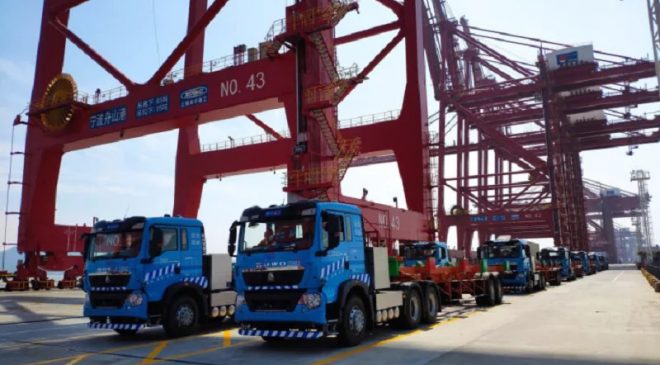
Smart container trucks represent a new breakthrough in the smart port transformation.
Recently, the international port city city in east China’s Zhejiang province. Its port, the Ningbo-Zhoushan Port, hybrid platooning of 5G smart and traditional container trucks with China Mobile Ningbo and Huawei.
To date, the port has reached a number of milestones, becoming the first in the industry to integrate 5G automated rubber-tired gantry (RTG) cranes into routine operation and implement 5G network slicing and 5G Super Uplink in port businesses.
Smart container trucks represent a new breakthrough in the smart port transformation. The trucks contain scaled application, to help deal with driver shortage and fatigue while improving efficiency and reducing safety risks. These trucks will also play an important role in replacing intensive labour in the port with unmanned, automated, and intelligent operations.
Smart container trucks require real-time 5G smart sensing, truck-road and truck-truck synergy, and video transmission. One container truck requires an uplink bandwidth of 20 to 30 Mbps and a low latency of below 20 minutes.
During peak hours, more than 40 container trucks will be working at the same time. This requires the network to ensure an uplink bandwidth of 1,200 Mbps.
The 5G can provide better network support for these applications, and is based on 3GPP Release 16, China Mobile and Huawei have developed a 5GtoB solution for port applications. Ample verification tests have been conducted, with results showing that the solution meets the requirements of smart container trucks on both network performance and stability.
With CPEs deployed to support dual feeding and selective receiving solution, the network further improves the quality and latency stability of smart container trucks’ signal transmission. As such, 5G has become a preferred network solution for full-function applications of smart container trucks.
In the Ningbo-Zhoushan Port, container trucks no longer have drivers — an important indicator of the automated logistics of 5G smart trucks in modern ports.
Powered by 5G and AI, upon detecting that containers unloaded from bridge cranes are properly loaded, container trucks automatically power on to move the containers to their destinations. During this process, they automatically identify nearby objects, machinery, and lighthouses and respond intelligently, such as decelerating, braking, steering, bypassing, and parking.
They can also accurately move to the RTG-specified positions along optimal routes provided by the smart dispatching system, meeting the demand for horizontal transfer in closed areas.
Looking to the future, the Ningbo-Zhoushan Port will continue to work with China Mobile Ningbo and Huawei as well as other industrial partners to further integrate upstream and downstream resources and promote the pilot and promotion of remote device control, smart tallying, unmanned driving, online AI port monitoring, and trunking communication based on 5G networks so as to build a comprehensive benchmark of 5G smart port.
Tags: 5GHuaweismart trucks




